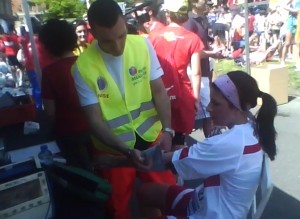 Due settimane fa, mentre mi allenavo per la Milano Relay Marathon, ho ricevuto un’e-mail a sorpresa. A scrivermi era l’assicurazione Europ Assistance, che offriva a tutti gli atleti sconti sulle polizze salute. Mi sono stupito, perché nego sempre il consenso a ricevere comunicazioni promozionali. Ho chiamato l’allenatore del gruppo di runners di cui faccio parte, che si era incaricato delle iscrizioni di tutti noi, e lui mi ha assicurato di essere molto attento a fare lo stesso. Forse, mi ha detto, Europ Assistance era riuscita a passare attraverso il filtro della legge sulla privacy perché erogava un servizio agli atleti: l’assicurazione sanitaria durante la gara. All’arrivo, letteralmente dieci metri dopo il traguardo, il personale Europ Assistance misurava “parametri sanitari” e, immagino, diffondeva informazioni sui propri prodotti.
Due settimane fa, mentre mi allenavo per la Milano Relay Marathon, ho ricevuto un’e-mail a sorpresa. A scrivermi era l’assicurazione Europ Assistance, che offriva a tutti gli atleti sconti sulle polizze salute. Mi sono stupito, perché nego sempre il consenso a ricevere comunicazioni promozionali. Ho chiamato l’allenatore del gruppo di runners di cui faccio parte, che si era incaricato delle iscrizioni di tutti noi, e lui mi ha assicurato di essere molto attento a fare lo stesso. Forse, mi ha detto, Europ Assistance era riuscita a passare attraverso il filtro della legge sulla privacy perché erogava un servizio agli atleti: l’assicurazione sanitaria durante la gara. All’arrivo, letteralmente dieci metri dopo il traguardo, il personale Europ Assistance misurava “parametri sanitari” e, immagino, diffondeva informazioni sui propri prodotti.
Le ragioni di un marketing tanto aggressivo nei confronti dei partecipanti a una corsa di fondo sono chiare. Assicurare noi maratoneti è molto redditizio, perché curiamo la nostra salute e in media pagheremo premi per molti anni prima di richiedere alle compagnie di pagare cure mediche. Mi chiedo però se le compagnie assicurative non siano tentate di fare anche il contrario, cioè NON assicurare chi non compare nei database associati a uno stile di vita sano (società sportive, iscritti a palestre etc.). Questo comportamento è vantaggioso per chi lo mette in atto (in questo caso le compagnie assicurative) ma dannoso per la società (non si condivide il rischio, e proprio chi ha più probabilità di avere bisogno di cure non le può ottenere). Se si verificasse, ne conseguirebbe che le assicurazioni private non sono uno strumento adatto a fornire assistenza sanitaria ai cittadini, e i decisori pubblici dovrebbero orientarsi decisamente verso la costruzione e la difesa di servizi sanitari nazionali.
Tra l’altro, l’elenco degli iscritti alla Milano Relay Marathon non è certamente il database più potenzialmente esplosivo dal punto di vista delle compagnie: la startup genomica 23andme sequenzia il vostro DNA a partire da un batuffolo di cotone inviato per posta, a partire da 99 dollari, e calcola i “fattori di rischio” di cento malattie. Nel dibattito sulle conseguenze sociali della diffusione generalizzata di Internet vedo agitare molte paure che la maggior parte degli esperti considera infondate: disimpareremo a leggere ogni testo più lungo di un tweet, ci rinchiuderemo in casa a chattare invece di uscire e incontrare persone interessanti come facevano i nostri socievoli genitori, ci intratterremo con pedofili e terroristi. Gli Internet-scettici, che hanno dato prova di una notevole vis polemica, potrebbero essere molto utili alla società impegnandosi su rischi concreti come quello della privacy sanitaria. E noi che abbiamo a cuore l’apertura dei dati (e siamo affamati di dati sul nostro correre) faremmo bene a chiederci seriamente se in questo caso la trasparenza non possa rivolgersi contro di noi.
(Qui un post più positivo sulla corsa come generazione e consumo di massa di dati di performance atletica)
